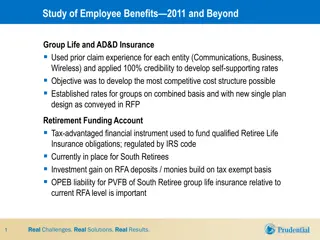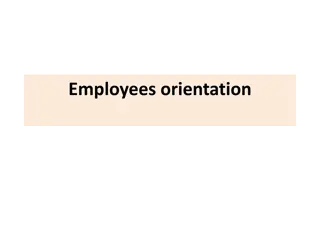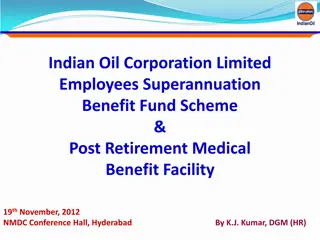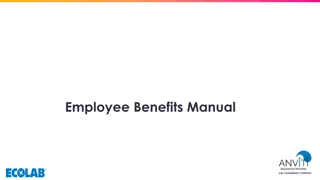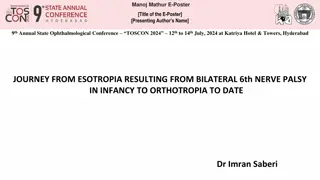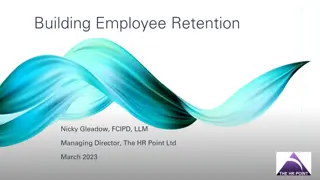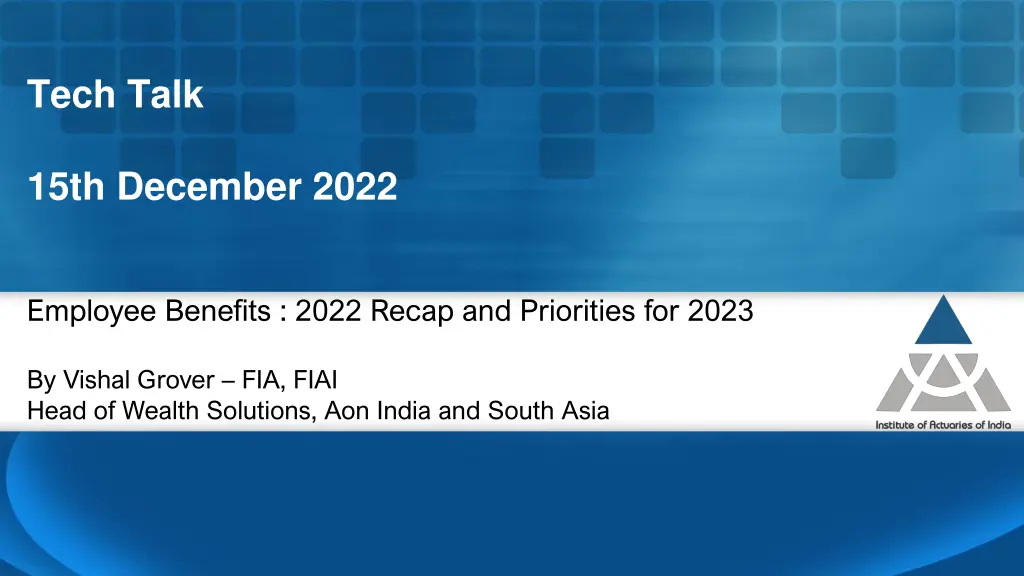
2022 Recap and 2023 Priorities in Employee Benefits and Economic Challenges: Insights by Vishal Grover
Get expert insights on the recent developments in employee benefits, including retirement schemes and salary increments, as well as a comprehensive overview of India's economic challenges and opportunities. Understand the volatility in actuarial assumptions and how it impacts various sectors. Stay informed about key trends shaping the future of employee benefits and the economy in 2023.
Download Presentation

Please find below an Image/Link to download the presentation.
The content on the website is provided AS IS for your information and personal use only. It may not be sold, licensed, or shared on other websites without obtaining consent from the author. If you encounter any issues during the download, it is possible that the publisher has removed the file from their server.
You are allowed to download the files provided on this website for personal or commercial use, subject to the condition that they are used lawfully. All files are the property of their respective owners.
The content on the website is provided AS IS for your information and personal use only. It may not be sold, licensed, or shared on other websites without obtaining consent from the author.
E N D
Presentation Transcript
Tech Talk 15th December 2022 Employee Benefits : 2022 Recap and Priorities for 2023 By Vishal Grover FIA, FIAI Head of Wealth Solutions, Aon India and South Asia
Index 1.Recent Developments and 2023 Outlook in the Retirement Benefits Space I. Volatility in Actuarial Assumptions II. Other Regulatory Developments Labour Codes National Pension System and Provident Fund 2.Spotlight on Employee Pension Scheme I. Developments and Impact II. Actuarial Illustration on EPS vs EPF www.actuariesindia.org
Indias Economy : New Challenges and Opportunities High risk of global recession as per World Bank Covid resurgence Inflation expected to be outside comfort zone of 4% Record collections in FY 2023 High inflation Global Recession Russia-Ukraine war impacting supply chains GDP at 6.5% to 7% for FY 2023 GST and Income Tax Strong festive season sales Geopolitics GDP Consumer demand Banks NPA Clean-up China + 1 Record profits posted by Banks, focus on credit growth www.actuariesindia.org
Volatility in Actuarial Assumptions Discount Rate Zero Coupon Yield Curve Rates at 5 Years, 10 Years and 20 Years of Maturity 8.00 7.50 7.00 6.50 6.00 5.50 5 Years 10 Years 20 Years 5.00 January 5.86 6.81 7.22 February 6.07 7.10 7.50 March 6.12 7.02 7.32 April 6.24 7.15 7.41 May 6.63 7.25 7.49 June 7.11 7.52 7.64 July 7.14 7.43 7.59 August 7.04 7.29 7.49 September 7.02 7.18 7.34 October 7.30 7.37 7.38 November 7.30 7.40 7.36 December 7.10 7.21 7.21 5 Years 10 Years 20 Years Higher interest rates led to higher yields by 50-100basis points reducing DB Balance Sheet liabilities by 5-10%, particularly at shorter durations. Signs of Inverted yield curves seen in the last quarter, signaling market expectations of a recession in near future Based on RBI projections of inflation at 5-6% for FY 2024, we expect yields may stabilize around 7.00% to 8.00% range in CY 2023 Increased volatility leading to demand for quarterly reviews of actuarial liabilities www.actuariesindia.org Source: The Clearing Corporation of India
Volatility in Actuarial Assumptions Salary Increment Double digit Salary Increases are back, after a decade! Top 3 Sectors E-commerce 13.7 | 12.8 10.6 10.4 9.5 9.3 9.3 Professional Services 12.4 | 12.1 Hi Tech/Information Technology 12.0 | 11.3 6.1 2022 Actual 2018 2019 2020 2021 2022(A) 2023(P) 2022 Projected Salary Increases by the Levels of Management While long term assumptions may remain unchanged, allowing for short term salary growth projections is recommended for better liability management 10.7 10.1 10.0 10.0 9.8 9.6 9.4 9.2 8.9 6.3 8.5 8.1 7.9 Important to allow different approach across industries and levels of management 6.0 5.1 2018 2019 2020 2021(A) 2022(P) Top & Senior Management Middle Management Junior Management www.actuariesindia.org Source: Aon India 28th Salary Increase Survey
Volatility in Actuarial Assumptions Attrition Rate Highest attrition in the last 5 years signifying the impact of Great Resignation on India Top 3 Sectors E-commerce 28.7 | 24.9 | 5.1 21.0 20.3 17.5 Professional Services 25.7 | 26.0 | 2.2 16.1 13.5 15.8 15.7 13.1 12.8 10.0 Financial Institutions 24.8 | 21.4 | 3.9 Overall Attrition Voluntary Attrition Overall Attrition Voluntary Attrition Involuntary Attrition 2018 2019 2020 2021 2022 Industry has seen record attrition in the last couple of years Attrition by Levels of Management 22.2 21.1 Important to allow for differentiation by industry and seniority (along with age and service) while setting long erm assumptions 18.2 13.9 13.7 13.5 11.7 9.2 11.2 10.7 Worth incorporating Involuntary assumption which may trigger special event (curtailment and settlement accounting) 7.4 6.2 2019 2020 2021 2022 Top & Sr Mgmt Mid Mgmt Jr Mgmt www.actuariesindia.org Source: Aon India 28th Salary Increase Survey
Proposed Labour Codes (India) : Updates and recent Developments Impact on Retirement Benefits Labour Codes Recent Updates 29 Labour Laws being consolidated into 4 Codes Government engaging with States and Unions to remove roadblocks Traditional concept of Basic Pay replaced by a concept of Wages impacting all statutory benefits Key Objectives include Most States (80%-90%) have accepted the Code on Wages and Social Security Codes Historically Basic Pay was 25%-40% of Gross Pay which could get replaced by Wages at 50%-70% of Gross Pay Reduce compliance burden E-Filing and digitization Enhance Social Security Improve labour relations Consistency in Pensionable Wages Overall Transparency and Ease of doing business Industry representations to Government on certain proposals Large incremental cost expected in DB plans like Gratuity and Leave encashment actuarial liabilities. Best estimate timeline for implementation appears to be Q2 of CY 2023 Employees cash in hand salary to be impacted if PF (DC) contributions go up National Labour Conference reiterates speedy roll-out of Labour Codes www.actuariesindia.org
Proposed Labour Codes (India) : Market Surveys Plan of action for Gratuity 4% Basic Salary as a % of Total Fixed Pay 8% Between 30 to 50% Continue uncapped benefit and absorb impact 29% 15% 38% Multiple ranges across employee groups N/A as our benefit is already capped at INR 20L Less than 30% 73% 33% More than 50% Exploring introducing a cap of INR 20L Plan of action on Basic Salary 3% Prevalence: Flexible Compensation Structure Unsure, waiting for clarity Our Compensation Structure is partially flexible and partially fixed. 14% 23% Increase Basic Salary to 50% of Gross Salary 47% Fixed Compensation Structure 51% 36% 26% Use Wages to calculate retirals Completely Flexible Compensation Structure Increase Basic Pay to include all allowances qualifying as Wages www.actuariesindia.org Source: Aon India Benefits Surveys
Proposed Labour Codes (India) : Impact on Rewards Current State Flexibility Possible Future State No Flexibility Benefits Re-design Considerations Percentage of Gross Pay Percentage of Gross Pay Components Components Lower Financial Impact on the Organization Compliance with Labour Codes Basic Salary 25 to 50% Basic Pay (Wages) 50% Flexibility on Tax-saving Benefits Protecting Cash-in-Hand for employees Flexible Allowance Basket Provident Fund Excluded Allowances Fixed allocations to following exclusions such that it makes up 50% of Gross/Base Pay House Rent Allowance Company Lease Accommodation Car Lease Less Complex Administration Market Benchmarks HRA LTA PF NPS Conveyance Statutory Bonus Special Work expenses 50% to 75% as per employee choice 50% Role of Actuaries Superannuation Actuaries to calculate cost of design change (past service cost) and incorporate within valuation reports NPS Professional Development Children Education Leave Travel Allowance Special Allowance Actuaries best placed to advise on re-design of Retirement and other Benefits allowing for all above factors Total Gross (Fixed) Pay 100% Support organisations make suitable budgetary allocations for increase in 2023 payroll costs allowing for above impacts Total Gross (Fixed )Pay 100% www.actuariesindia.org
National Pension System Updates 2022 Updates Option to change investment choice and asset allocation 4 times a year (eff. 1 Feb 2022) 2023 Possible changes or proposals Commentary from PFRDA suggests developments in the following areas Upward revision of POP charges to incentivize POPs to actively distribute and promote NPS Potential of introduction of a variable annuity product aimed at shielding retired members against inflation. Option to allocate 75% to equities without tapering from age 51 Minimum Assured return scheme (MARS) for those who remain invested for specified number of years (and introduction of other guarantees within the MARS scheme) Withdrawal requests timelines reduced from T+4 to T+2 days Miscellaneous other tech updates could be found at npstrust.org.in Potential of conflict between Centre and States on the re-introduction of the Old Pension scheme (instead of National Pension System) www.actuariesindia.org
Provident Fund Updates 2022 Updates 2023 Possible changes or proposals The Central Board of Trustees (CBT) declared a rate of interest of 8.10% to be credited on Employee Provident Fund accumulations for FY 2021-22 Interest rates on EPF may stabilise at around 8% p.a. (as interest rates and yields have gone up in the last 6 months) Review of wage ceiling and headcount restriction to allow all formal workers and the self-employed to enrol in its retirement saving schemes. Supreme Court allows members to opt for Employees Pension Scheme on full wages (and not restricted to capped pay of INR 15,000 per month). Detailed discussion in the following slides Possible increase its investments in equities to up to 20 % from the current limit of 15%. www.actuariesindia.org
Employees Pension Scheme (EPS) Recap of EPS scheme Summary and impact of recent Supreme Court judgement Potential Implications on Employees www.actuariesindia.org
Introduction : Employees Pension Scheme EE 12% of pay p.m. ER 12% of pay p.m. minus EPS contribution Provident Fund Lump Sum Provident Fund Act 8.33% of Basic Pay capped at 15,000 p.m.= 1,250 p.m. Employees Pension Scheme Monthly Pension Option to contribute EPS on full salary and receive EPS pension on full salary is being litigated between EPFO and members on full salary is being litigated between EPFO and members Option to contribute EPS on full salary and receive EPS pension Parameter Description Parameter Description Employer contribution 8.33% on wage capped at INR 15,000 p.m. Pension to spouse on death 50% of member pension Child/Orphan Pension Yes Government contribution 1.16% of wages Min age/service for receiving early pension 50 years/10 years Employee Contribution None (1.16% only for uncapped EPS scheme) Early Pension reduction factor 4% p.a Pension Formula 1/70 x Service x Applicable Pay p.m. Pension Liability Sits with EPFO Max Pensionable service 35 years
Key highlights from the Supreme Court judgement Key summary of the judgement dated 22nd November 2022 Supreme Court concluded the hearing on the long outstanding case related to extending the uncapped EPS scheme to all members without any restriction Key points in the judgement Amendments in the 2014 EPFO notification are valid and Government has authority to amend the PF/EPS plan Employees who did not exercise the option on uncapped salary earlier to be given an option to join EPS again without any cap on salary. Choice to contribute at uncapped pay to be exercised within 4 months Members of exempted establishments also to be given a choice to join uncapped EPS pension scheme Pre-2014 retired employees who did not opt for the uncapped Pension plans are not to be given the option again to join the uncapped EPS plan Employees need not contribute at 1.16% of pay going forward to get uncapped EPS pension Pensionable salary for calculating EPS pension at retirement would be calculated at 60 months last drawn average salary. (instead of 12 months). www.actuariesindia.org
Key highlights from the Supreme Court judgement Impact of the judgement Some provisions of the 2014 EPFO amendments most likely would continue particularly around exclusion of new members from EPS above the minimum salary threshold of INR 15K per month. Therefore, the scheme over a period of time is expected to become closed to new joiners Presents opportunities to members (particularly closer to retirement) to enhance their retirement benefits by opting for uncapped EPS pension Potential large shift of active and retired employees and funds from PF to EPS scheme. Government most likely to bear the contribution of 1.16% of pay which is currently being paid by the employee to receive uncapped pension further benefiting the employees Complex to implement changes logistically therefore the Government/EPFO may seek more time. Employers and employees may need to support government by providing accurate and up to date data as per prescribed details There is no financial impact on the employer as the EPS liability sits with the government, however, watch out for any changes in the Act which may require employers to contribute more. www.actuariesindia.org
EPF vs Uncapped EPS Sample Illustration explaining Opportunity Cost consideration Current EPS (capped) INR 15,000 per month 8.33% of capped salary of 15K p.m. N/A (as member starts at 15K p.m.) INR 15,000 p.m. (capped) 35 years 1/70 x INR 15,000 x 35 = INR 7,500 p.m. INR 22 lakhs Proposed EPS (Uncapped) INR 15,000 per month 8.33% of uncapped salary 6% p.a. INR 97,000 p.m. (uncapped avg of 5 years) 35 years 1/70 x INR 97,000 x 35 = INR 49,000 p.m. INR 46 lakhs Salary at joining (at 23 years) Contribution to EPS Salary increase p.a. Pensionable Salary at retirement (58 years) Service period Actual Pension (A) Cumulative value of Contributions@7% int Pension obtainable from market (B) INR 13,000 per month INR 28,000 p.m. Loss to employee = INR 5,500 p.m. OR 40% lower Gain to employee = INR 21,000 p.m. OR 75% higher Gain/Loss in Pension (A-B) Uncapped EPS scheme appears to be financially more lucrative as compared to the PF plan and the gap becomes more visible for those nearing retirement in the next few years if allowed to opt for uncapped EPS retrospectively from date of joining the scheme www.actuariesindia.org
EPS or EPF : Considerations for employees to choose Marco- economic Individual Career Government Financial Analysis Age Dependents Existing and inherited assets Early retirement International relocation Freelancing / Gig Ability to pay Political Stability Changes in legislation Interest rate Annuity rates Investment style Taxation Health Lifestyle PF is tax free EPS pension is taxed Future changes in tax legislation Life expectancy Current and future expectation on one s state of health Targeted investments on retirement (house, vacation, car) Could the member outperform PF and EPS returns via active investment into different asset classes? Actuaries can provide support to various stakeholders to ensure a smooth transition www.actuariesindia.org
Any questions ? www.actuariesindia.org





